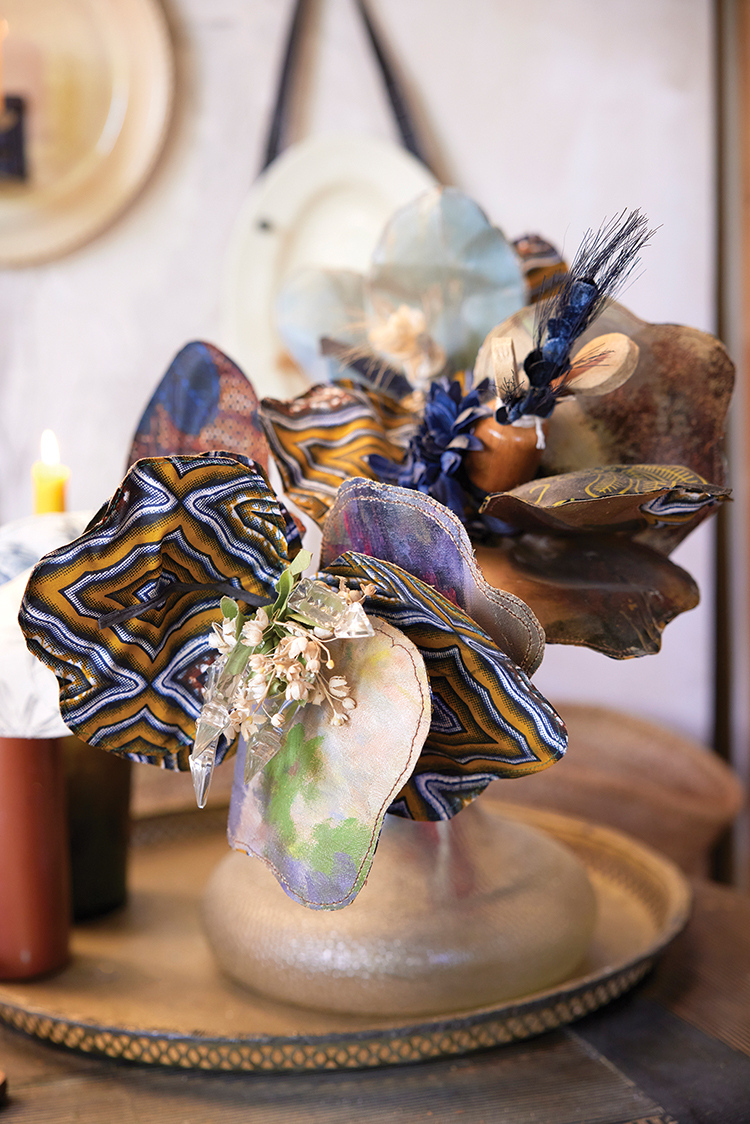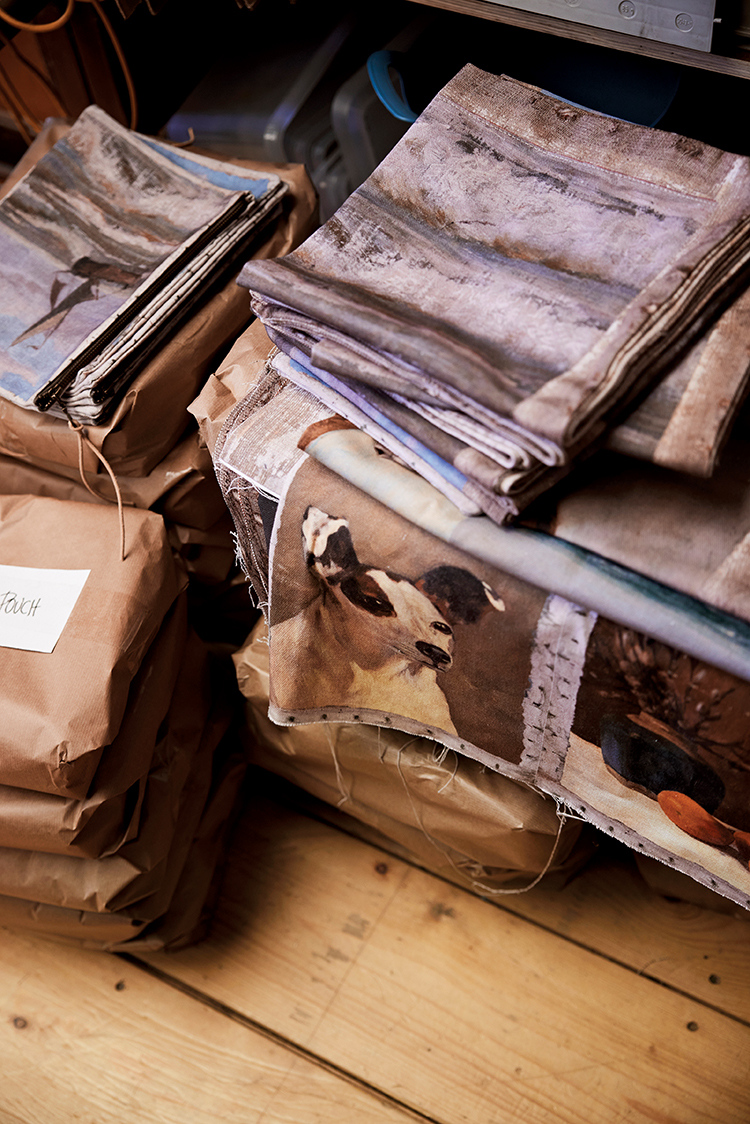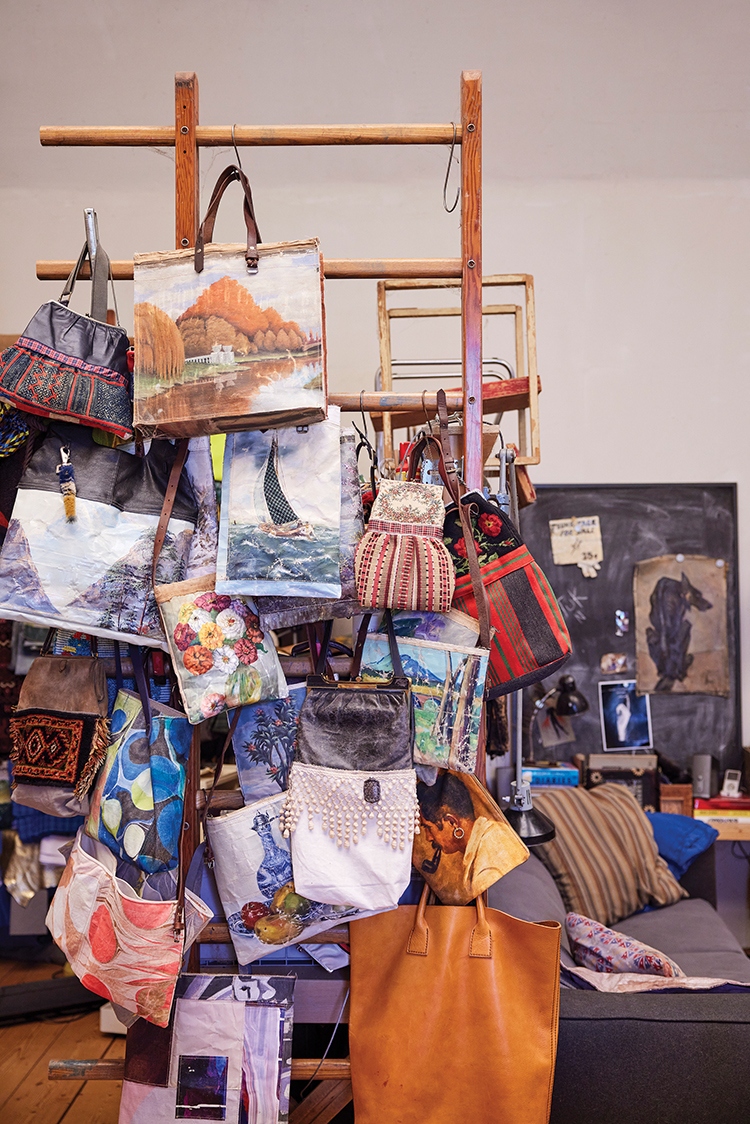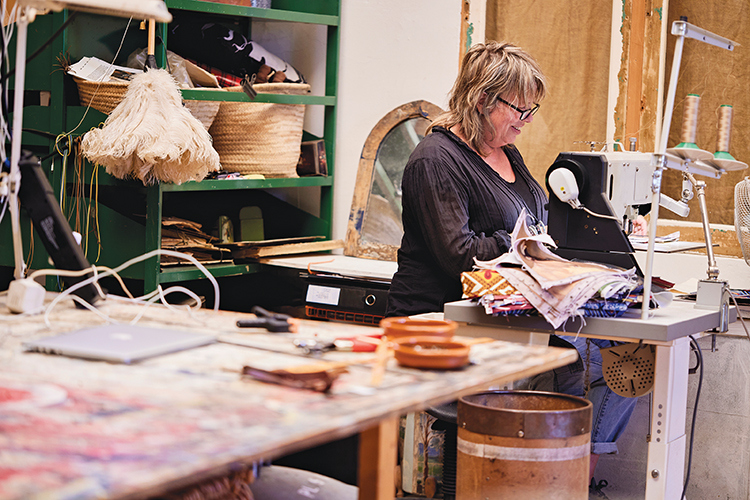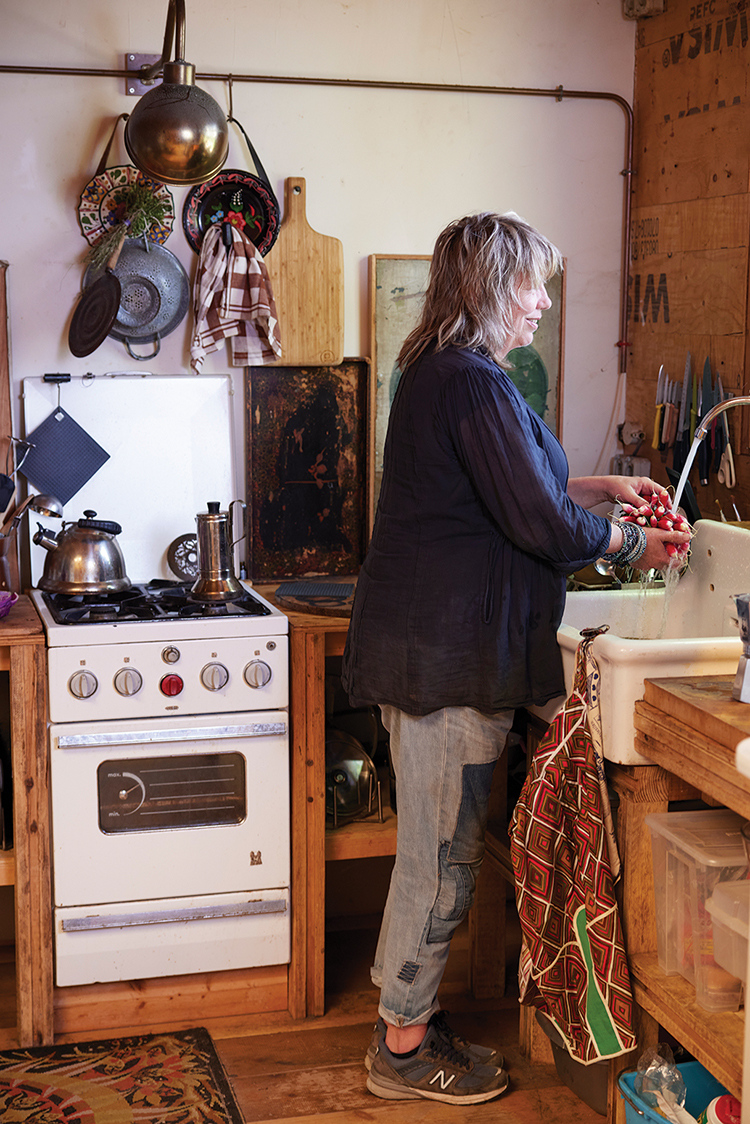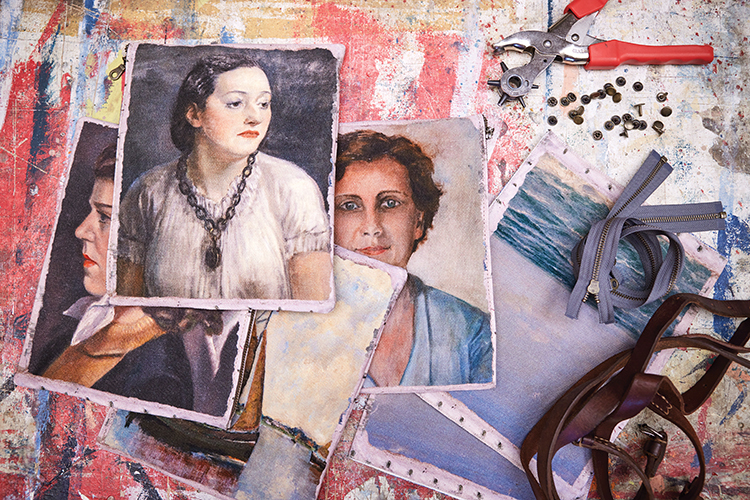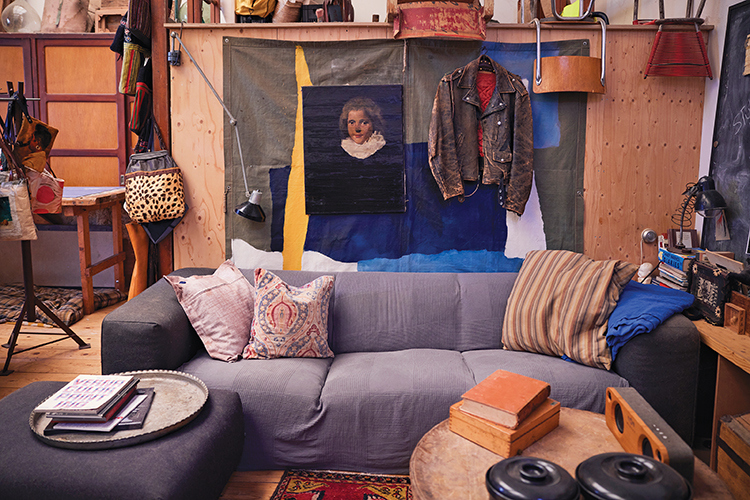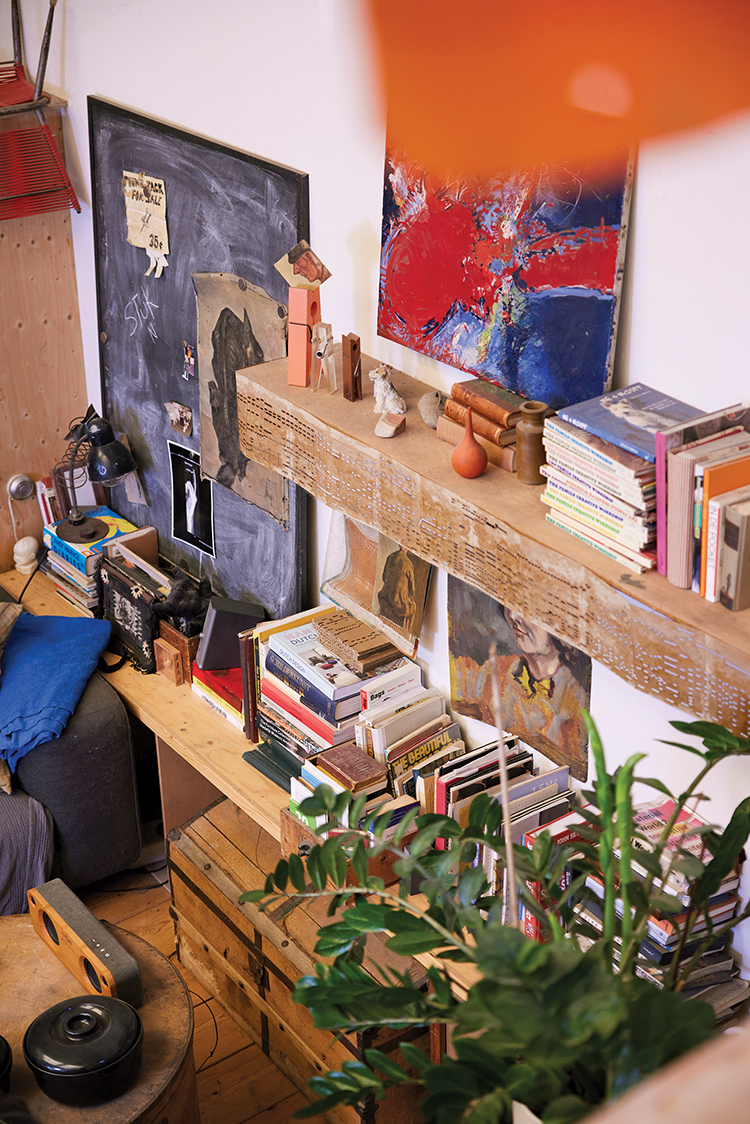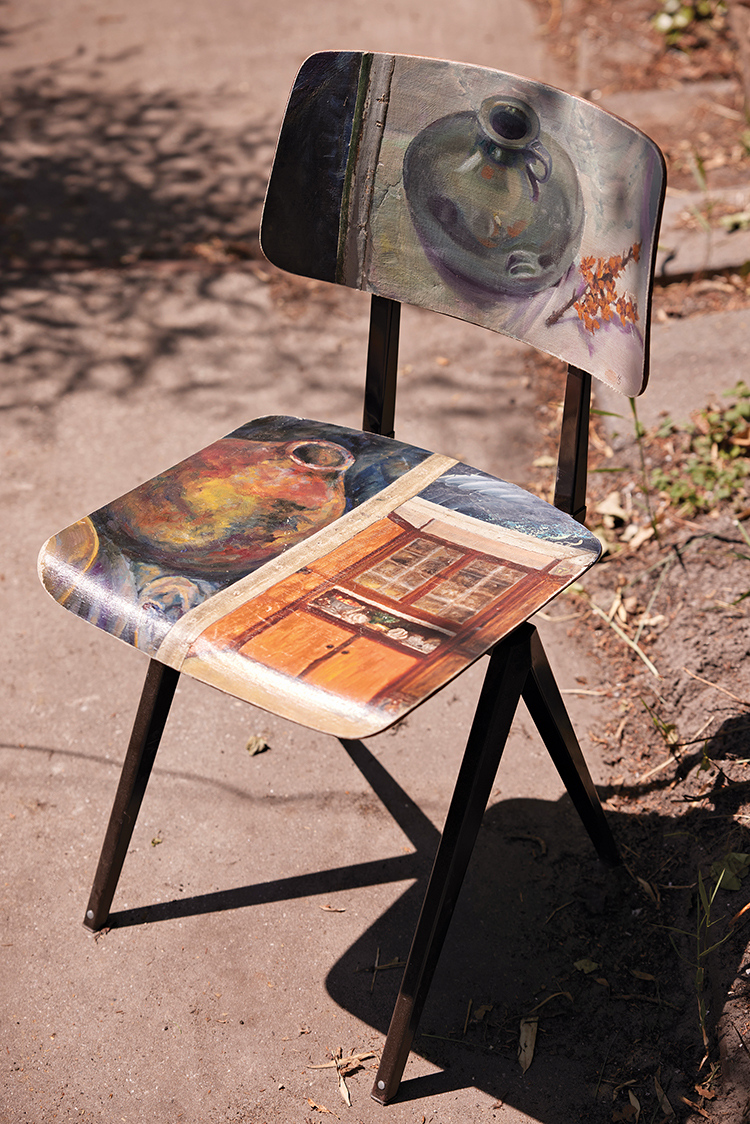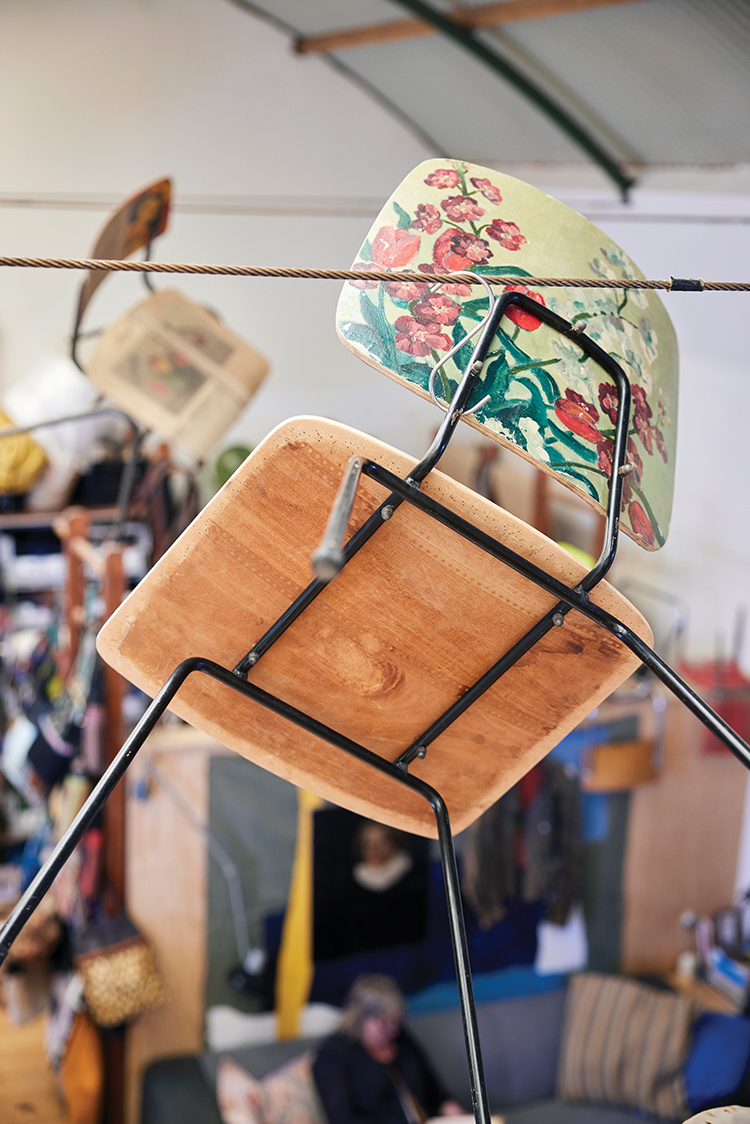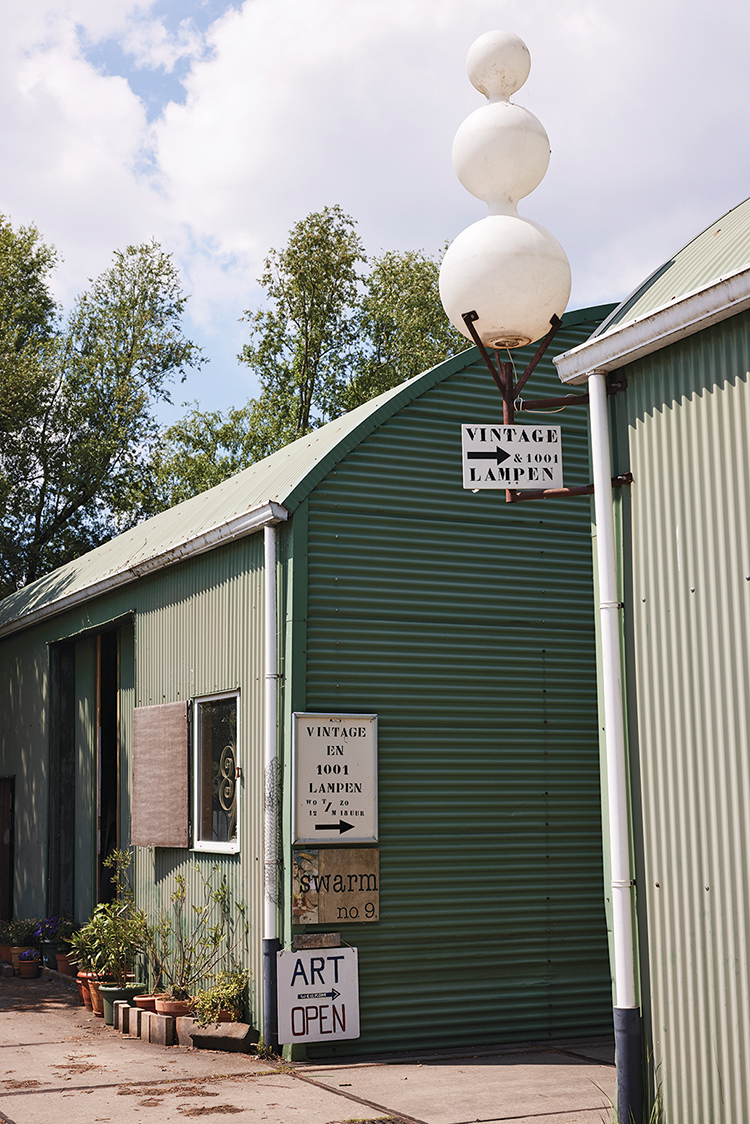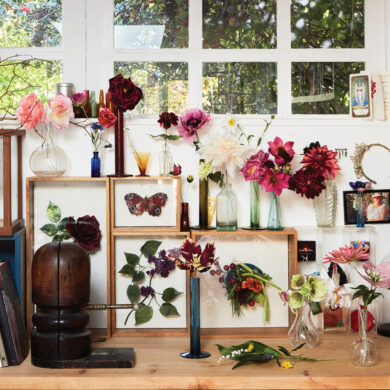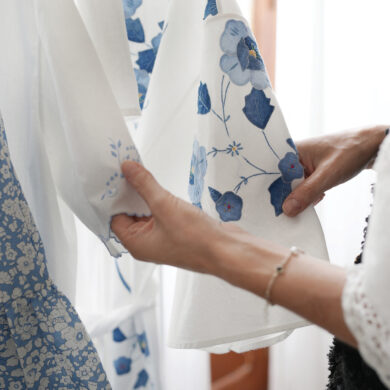A Hidden Oasis and New Life in the Center of Amsterdam
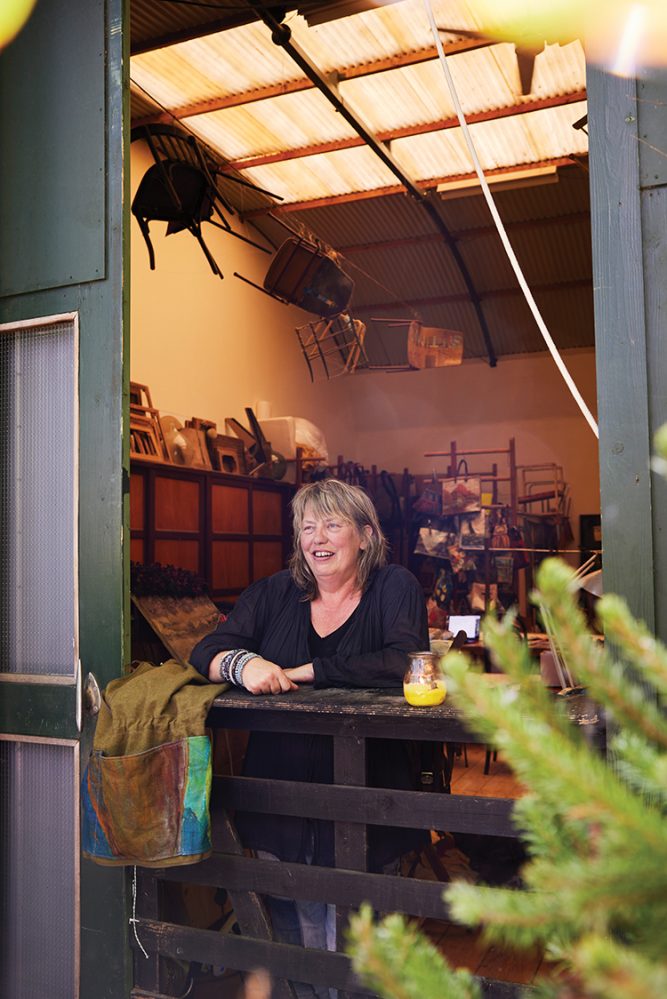
I was born in Rochester, New York, in the early ’60s. I never imagined I would be living in the Netherlands running my own business, but here I am with a Dutch passport!
My father is Dutch, and my mother is American/Canadian, so I grew up hearing stories about Holland and Canada. I am the product of a creative family. My father was an interior designer, my aunts and uncles all worked in retail display, and my mother was always sewing and crafting at home. My first job was doing window displays for a small specialty store in Rochester. That was at a time when window displays were theater.
I went on to John Wanamaker in Philadelphia during the heyday of department stores. Conran’s Habitat gave me my next opportunity, which was a big turning point for me. I found I loved working with home goods, not just fashion. I was perfectly placed for the next job: Anthropologie! What an amazing experience. I moved from the East Coast to Seattle to open their 11th store. Little did I know I would be there from store 11 to store 80! It was like a college education of learning on the job. It really tested my experience — there was little direction and lots of freedom — but I got into the swing of it and flourished. It was all about storytelling.
I worked my way up to visual director in the home office in Philadelphia. But the higher I moved up, the more the job changed from creative freedom to a more analytical management role. Ick.
After being involved with design merchandising in 80 stores, I was feeling burnt out. The joys of profit sharing gave me new opportunities. What to do? Buy a house? I am not a quitter, but yeah, I am! I quit, sold everything and moved to Amsterdam with four boxes.
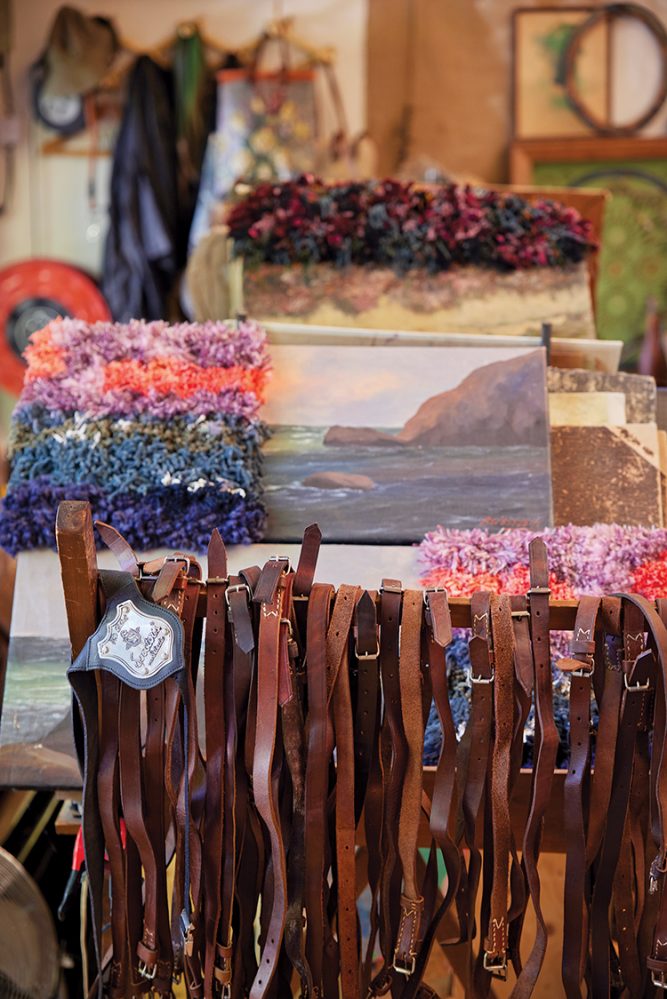
I didn’t have a plan beyond taking time to think about what I wanted to do next. I got a cute apartment as a base and from Amsterdam did some amazing travel: Sweden, Denmark, Germany, Italy, France, Croatia and then Africa. Africa tugs at my heart and spoiled me — European cities were not so much my interest after that.
My next trip was to the Highlands in Scotland. Three weeks in a camper van. Africa and Scotland sound so different, but they share something. Both are untamed and so beautiful.
Travel done for the moment, I needed to work. I got a dog, a pivotal moment for me. McDuff was a very confident, adventurous, once-in-a-lifetime dog. Together, we explored our new city and walked so many towns and cities in the Netherlands, hitting lots of flea markets along the way. I would gather interesting things but primarily paintings, oil paintings — sooooo many of them — something you would just not see in such quantities in the USA.
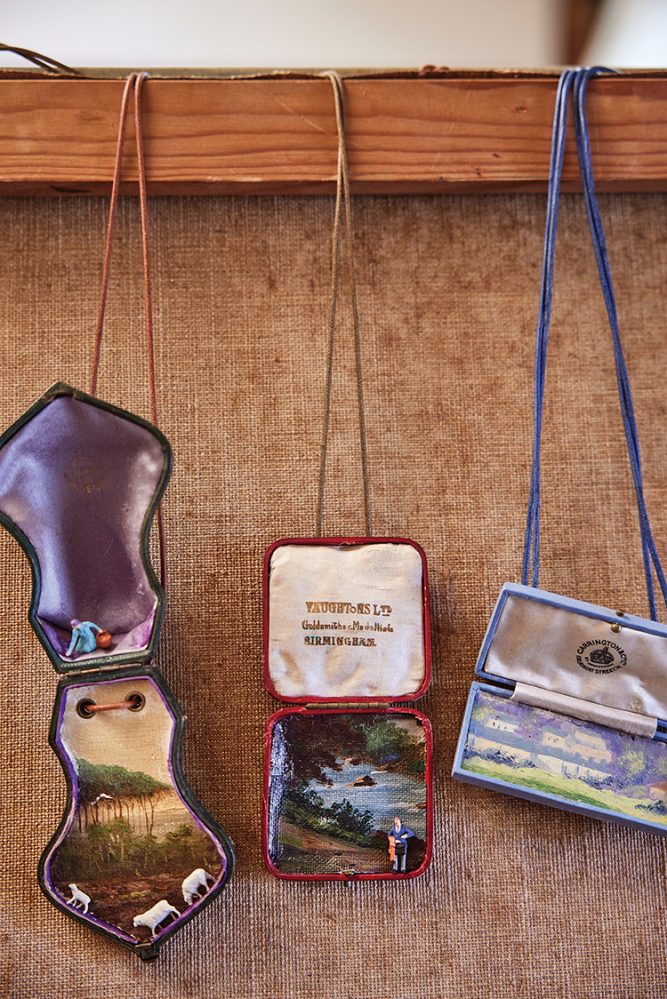
Timeworn finds always have a built-in story.
I started having ideas of things to make, experimenting with designs. I make bags from original oil paintings. I cover old furniture, chairs and tables with paintings. These are all unique one-off pieces that I sell to customers and stores around the globe. It feels great to work with my hands again. I also print images of my favorite paintings on canvas, so I can make pillows and pouches for larger-quantity orders. I use tiny bits of painted scenes to create miniature diorama necklaces — tiny scenes of everyday life encased in old jewelry boxes.
From offcuts of paintings, I make leaves and flowers — nothing is wasted. Other necklaces are made from old piano keys and cord hammers. I like working with things with a long history.
Making something new out of something old has always been a big interest of mine.
After living in the Jordaan in Amsterdam, a very historic charming area, for some years, I had the chance to move to a special place. I was working with a woodworker, creating tables for Anthropologie. His workshop was in a very hidden part of Amsterdam, a wonderful little island of artists working out of 14 corrugated metal workspaces. I really wanted to live there! In the USA, we call them Quonset huts. Here, I call them home!
One day, one came up for rent, and I have been here seven years. I don’t think I could live in a regular home or apartment again. The space here is large and cavernous. I live in my studio and wouldn’t have it any other way. I like to look at my work round the clock. I have plenty of space for my vast collection of paintings, furniture and fabrics.
I wake up to birdsong and find inspiration in the green oasis around me. Green as it is, we also have all kinds of businesses around us. A scaffolders yard on one side, a metal recycling yard on another, plus two dog daycare parks! McDuff passed in 2019, and it broke my heart, but I have another dog now, STuK. He is a rare breed called Berger Picard, a French herding dog. McDuff was my protector, and I am STuK’s protector. He is so incredibly heartfelt, sweet and emotional. His name has some interesting meanings. He was the last in his litter to be born — literally, stuck! The Dutch have a term, “lekker stuk,” which typically means a nice-looking girl or boy, so my dog STuK is just that, a fox!
It feels great to work with my hands.
I am very careful how I select paintings for each project. Fragile paintings are great for chairs and tables, as they get sanded and sealed. Dioramas need finer paintwork and clear detail. I make many bags with “altered” paintings. For these, I swap out bits of the painting and replace it with fabric, or I embroider or add crewel work over the top. My yarn paintings are a combination of an original painting that I sew yarn onto to mimic the color and create another dimension. I have to be very selective about these: Not all paintings work with this technique.
I really like portraits of people and use many of these in my work. Of course, some paintings are too good to ever cut up, and I keep those. I am very careful with the details of finish on my work. The bags must have recycled straps of worn, but very good quality, leather. The rivets and findings are very specific.
If I am printing multiples on canvas, I make sure the photography and printing are the best quality, so I don’t lose the details — brushstrokes, cracking, painted edges; these are all really important to the character and look of my work. I print on high-quality fabric, which is textured and heavy. I want to ensure my work stands out with a distinction of staying true to the essence of the original painting. They have a depth and soul that shows in the small details of little imperfections.
Keith Johnson is a friend from my Anthropologie days. He was the found-objects and art buyer, with a keen eye and always good advice. He was my first customer and encouraged me to keep going and create more products. The name of my business is Swarm, like a mass of something — like bees or starlings. One of something is not so interesting but something en masse really is; a single thimble is an item, but a hundred strung together is a statement, a lesson I learned and like from design merchandising.
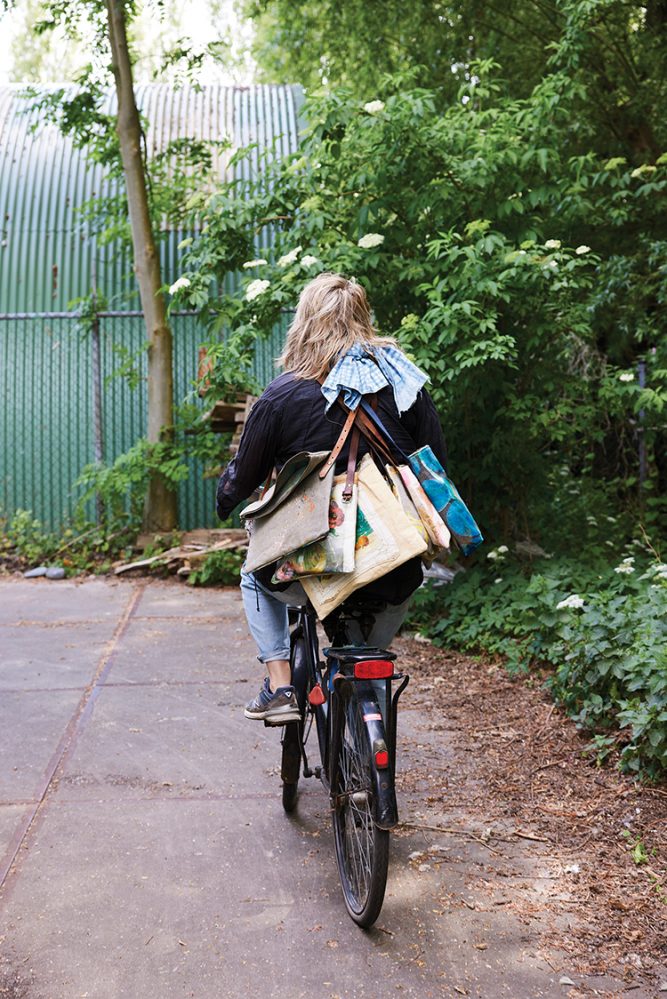
I am building my brand by staying true to the concept. I like materials that have a soul.
My products are sold and enjoyed all over the world. And I have been lucky enough to collaborate with great companies like Anthropologie, The Conran Shop, the Met Store and John Derian. But I love living and working here! How great is it to make a local delivery by bike?!
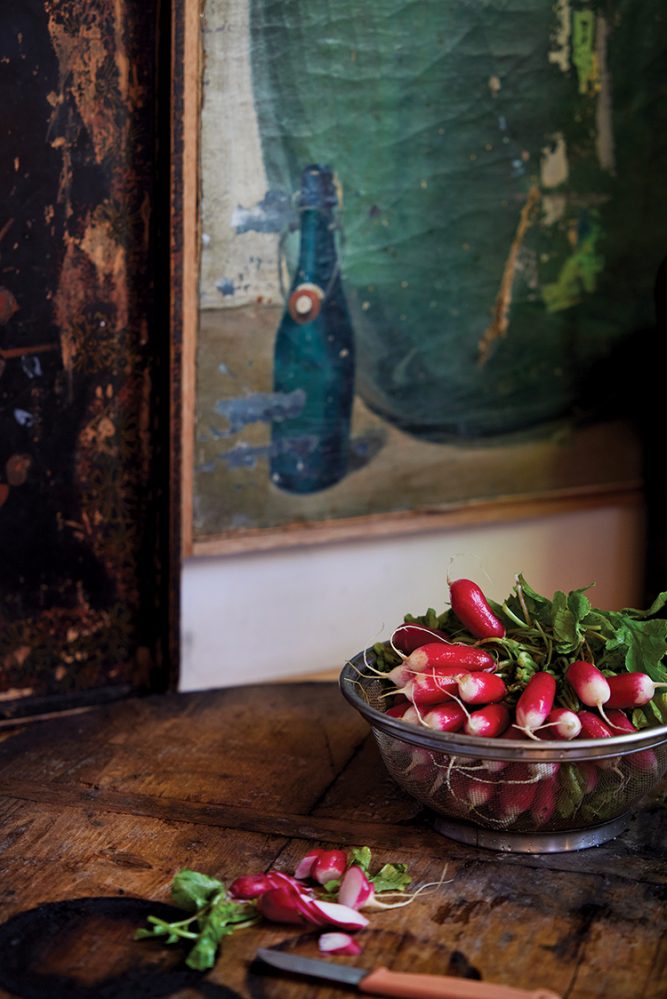
Stacy’s take on Leslie
Leslie has an amazing ability to take something old, add something new and make that transition seem seamless, like they were always meant to be together.
Leslie’s studio is like a still-life painting in real time. Vegetables on her counter or coffee on her denim-clad table remind me of Dutch painters like Willem Claesz. Heda or Clara Peeters. The colors in her studio mimic that Golden Age of art without trying to.
Her attention to the finishes on her work elevates it from recycled goods to art. But it is art you can wear and live with. Nothing is precious; everything has practical purpose.
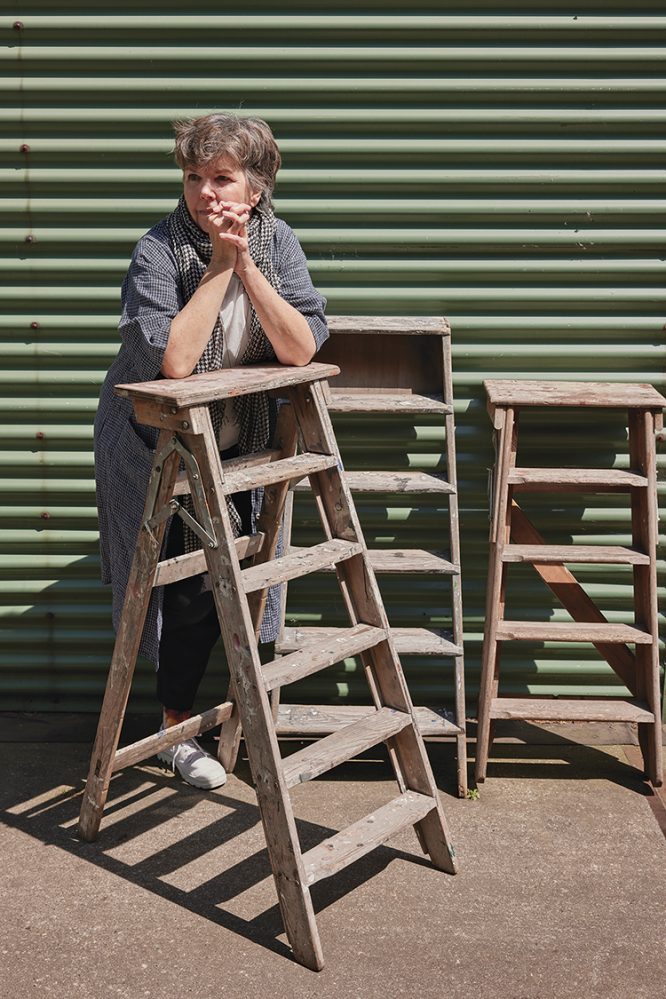
More on Stacy:
A retail specialist in buying, styling and store concept design, Stacy Sirk has deep lifestyle roots and decades of international experience. She is renowned for her uncommon creativity, found-object expertise, and the ability to translate progressive ideas into memorable expressions. She has worked with global brands, including Restoration Hardware, Nordstrom, Terrain and Nike, and also regularly collaborates with publishers to create books and magazine features.
www.SirkAtWork.com
A Hidden Oasis and New Life in the Center of Amsterdam

I was born in Rochester, New York, in the early ’60s. I never imagined I would be living in the Netherlands running my own business, but here I am with a Dutch passport!
My father is Dutch, and my mother is American/Canadian, so I grew up hearing stories about Holland and Canada. I am the product of a creative family. My father was an interior designer, my aunts and uncles all worked in retail display, and my mother was always sewing and crafting at home. My first job was doing window displays for a small specialty store in Rochester. That was at a time when window displays were theater.
I went on to John Wanamaker in Philadelphia during the heyday of department stores. Conran’s Habitat gave me my next opportunity, which was a big turning point for me. I found I loved working with home goods, not just fashion. I was perfectly placed for the next job: Anthropologie! What an amazing experience. I moved from the East Coast to Seattle to open their 11th store. Little did I know I would be there from store 11 to store 80! It was like a college education of learning on the job. It really tested my experience — there was little direction and lots of freedom — but I got into the swing of it and flourished. It was all about storytelling.
I worked my way up to visual director in the home office in Philadelphia. But the higher I moved up, the more the job changed from creative freedom to a more analytical management role. Ick.
After being involved with design merchandising in 80 stores, I was feeling burnt out. The joys of profit sharing gave me new opportunities. What to do? Buy a house? I am not a quitter, but yeah, I am! I quit, sold everything and moved to Amsterdam with four boxes.

I didn’t have a plan beyond taking time to think about what I wanted to do next. I got a cute apartment as a base and from Amsterdam did some amazing travel: Sweden, Denmark, Germany, Italy, France, Croatia and then Africa. Africa tugs at my heart and spoiled me — European cities were not so much my interest after that.
My next trip was to the Highlands in Scotland. Three weeks in a camper van. Africa and Scotland sound so different, but they share something. Both are untamed and so beautiful.
Travel done for the moment, I needed to work. I got a dog, a pivotal moment for me. McDuff was a very confident, adventurous, once-in-a-lifetime dog. Together, we explored our new city and walked so many towns and cities in the Netherlands, hitting lots of flea markets along the way. I would gather interesting things but primarily paintings, oil paintings — sooooo many of them — something you would just not see in such quantities in the USA.

Timeworn finds always have a built-in story.
I started having ideas of things to make, experimenting with designs. I make bags from original oil paintings. I cover old furniture, chairs and tables with paintings. These are all unique one-off pieces that I sell to customers and stores around the globe. It feels great to work with my hands again. I also print images of my favorite paintings on canvas, so I can make pillows and pouches for larger-quantity orders. I use tiny bits of painted scenes to create miniature diorama necklaces — tiny scenes of everyday life encased in old jewelry boxes.
From offcuts of paintings, I make leaves and flowers — nothing is wasted. Other necklaces are made from old piano keys and cord hammers. I like working with things with a long history.
Making something new out of something old has always been a big interest of mine.
After living in the Jordaan in Amsterdam, a very historic charming area, for some years, I had the chance to move to a special place. I was working with a woodworker, creating tables for Anthropologie. His workshop was in a very hidden part of Amsterdam, a wonderful little island of artists working out of 14 corrugated metal workspaces. I really wanted to live there! In the USA, we call them Quonset huts. Here, I call them home!
One day, one came up for rent, and I have been here seven years. I don’t think I could live in a regular home or apartment again. The space here is large and cavernous. I live in my studio and wouldn’t have it any other way. I like to look at my work round the clock. I have plenty of space for my vast collection of paintings, furniture and fabrics.
I wake up to birdsong and find inspiration in the green oasis around me. Green as it is, we also have all kinds of businesses around us. A scaffolders yard on one side, a metal recycling yard on another, plus two dog daycare parks! McDuff passed in 2019, and it broke my heart, but I have another dog now, STuK. He is a rare breed called Berger Picard, a French herding dog. McDuff was my protector, and I am STuK’s protector. He is so incredibly heartfelt, sweet and emotional. His name has some interesting meanings. He was the last in his litter to be born — literally, stuck! The Dutch have a term, “lekker stuk,” which typically means a nice-looking girl or boy, so my dog STuK is just that, a fox!
It feels great to work with my hands.
I am very careful how I select paintings for each project. Fragile paintings are great for chairs and tables, as they get sanded and sealed. Dioramas need finer paintwork and clear detail. I make many bags with “altered” paintings. For these, I swap out bits of the painting and replace it with fabric, or I embroider or add crewel work over the top. My yarn paintings are a combination of an original painting that I sew yarn onto to mimic the color and create another dimension. I have to be very selective about these: Not all paintings work with this technique.
I really like portraits of people and use many of these in my work. Of course, some paintings are too good to ever cut up, and I keep those. I am very careful with the details of finish on my work. The bags must have recycled straps of worn, but very good quality, leather. The rivets and findings are very specific.
If I am printing multiples on canvas, I make sure the photography and printing are the best quality, so I don’t lose the details — brushstrokes, cracking, painted edges; these are all really important to the character and look of my work. I print on high-quality fabric, which is textured and heavy. I want to ensure my work stands out with a distinction of staying true to the essence of the original painting. They have a depth and soul that shows in the small details of little imperfections.
Keith Johnson is a friend from my Anthropologie days. He was the found-objects and art buyer, with a keen eye and always good advice. He was my first customer and encouraged me to keep going and create more products. The name of my business is Swarm, like a mass of something — like bees or starlings. One of something is not so interesting but something en masse really is; a single thimble is an item, but a hundred strung together is a statement, a lesson I learned and like from design merchandising.

I am building my brand by staying true to the concept. I like materials that have a soul.
My products are sold and enjoyed all over the world. And I have been lucky enough to collaborate with great companies like Anthropologie, The Conran Shop, the Met Store and John Derian. But I love living and working here! How great is it to make a local delivery by bike?!

Stacy’s take on Leslie
Leslie has an amazing ability to take something old, add something new and make that transition seem seamless, like they were always meant to be together.
Leslie’s studio is like a still-life painting in real time. Vegetables on her counter or coffee on her denim-clad table remind me of Dutch painters like Willem Claesz. Heda or Clara Peeters. The colors in her studio mimic that Golden Age of art without trying to.
Her attention to the finishes on her work elevates it from recycled goods to art. But it is art you can wear and live with. Nothing is precious; everything has practical purpose.

More on Stacy:
A retail specialist in buying, styling and store concept design, Stacy Sirk has deep lifestyle roots and decades of international experience. She is renowned for her uncommon creativity, found-object expertise, and the ability to translate progressive ideas into memorable expressions. She has worked with global brands, including Restoration Hardware, Nordstrom, Terrain and Nike, and also regularly collaborates with publishers to create books and magazine features.
www.SirkAtWork.com






